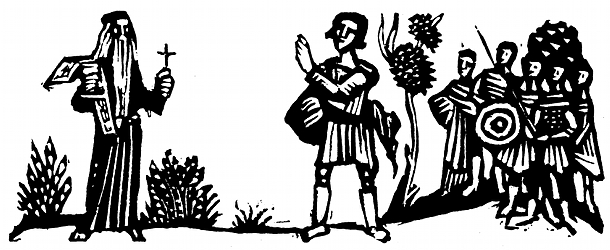The Warrior / Priest
This is a woodcut made by my wife's grandfather: Spyros Vassiliou was (until his death in 1984) a great artist, and was a part of an important community of Greek painters in the middle of the 20th century. He also designed sets and costumes for the theater, which is how he met my father-in-law, a playwright from Yale who ended up marrying the painter's daughter. My wife was the first child of that union, and met me in the theater department at Bennington College. And that's pretty much how I came to be in possession of the above woodcut.
I love Spyros' paintings, but I love his woodcuts even more. The artist turned to wood during World War II, when painting supplies were scarce, and during a time when the Germans occupied Greece (the German military had, in fact, a kind of base of operations in the old house that became my wife's family's home).
The woodcuts are simple and display big symbolic themes (freedom, hope, peace, etc), as you'd expect from a war-time body of work. But the woodcut above is entirely unique in the collection.
It shows a Greek ship in a storm, which itself is not unique in a maritime culture. What is unique is that the ship is covered with devils who are threatening to tear the ship to bits, as if the storm was not enough of a threat. Also surprising is that the picture-story is not about brave Greek sailors fighting to save the ship, but about an old priest who stands in the scene praying. Now, I understood this artist to be, like most Greeks, only culturally Christian, even though he was commissioned to paint the interiors of several orthodox churches: there is little sign in his work (or in his family line, I'm sorry to say) of a vibrant faith. But what am I to make of this picture? This is a picture that betrays a faithful vision.
Where did this painter get the idea that priests are warriors? Let's not focus unfairly on Greece, or on the orthodox countries: in no country do priests or pastors tend to reveal themselves to be more than quiet and somewhat harmless participants in society, who know their place. I'm not aware of any stories of bravery among the Greek priesthood during the war, and anyway, this is not that kind of militant courage. It takes a different kind of vision to see the true occupation of the priest-who-is-also-a-warrior.
The ship in the image is a symbol for the church, of course, and this priest is not just fighting the only fight that a priest is suited for, but the only real fight there is. St. Paul writes in his letter to the Ephesian Christians that, "Our struggle is not against flesh and blood, but against the ... world forces of ... darkness, against the spiritual forces of wickedness in the heavenly places." This woodcut is a really cool depiction of the hidden power of the priest.
What is equally exciting to me, is that this artist, great-grandfather to my son and daughter, seems to understand that the church is more than capable of surviving rough water ... and that the wise priest sees, with the eyes of the spirit, that the danger to a ship is never really the storm itself, but those forces that threaten to reduce the seaworthiness of the vessel.
Labels: art





